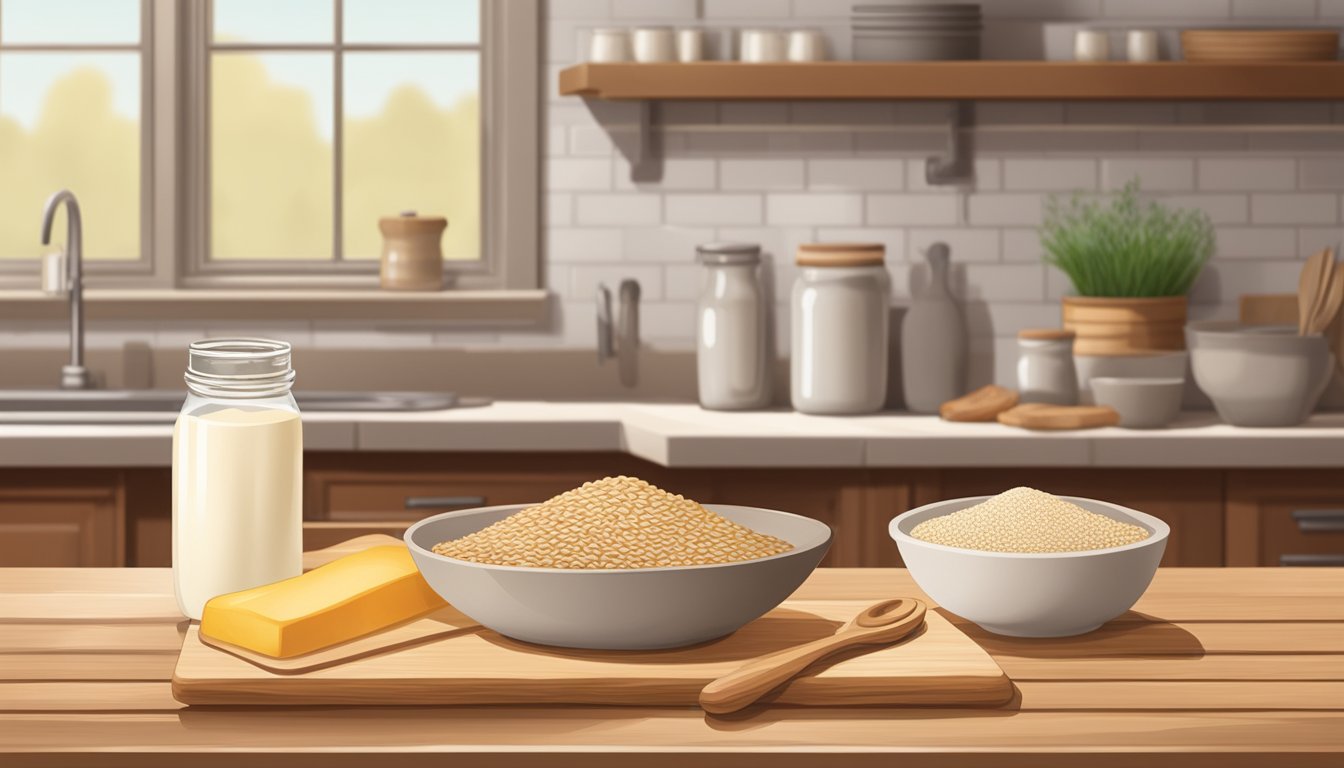Kamut, an ancient grain with a rich nutritional profile, has been gaining popularity as a breakfast staple. This versatile wheat variety offers a nutty flavor and chewy texture, making it an excellent base for various morning meals. Kamut contains 9.8 grams of protein and 7.4 grams of fiber per cooked cup, providing a nutritious start to the day.
Preparing breakfast kamut is straightforward and can be adapted to suit different tastes. The grain can be cooked similarly to oatmeal, creating a hearty porridge that can be customized with an array of toppings. For those who prefer savory options, kamut can be incorporated into breakfast bowls with vegetables, eggs, and cheese.
From sweet to savory, the possibilities for breakfast kamut are endless. Whether it’s a simple porridge with fruit and cinnamon or a more elaborate bowl with sautéed vegetables and a poached egg, kamut offers a nutritious and satisfying foundation for the first meal of the day.
Understanding Kamut

Kamut, also known as khorasan wheat, is an ancient grain with a rich history and impressive nutritional profile. This versatile whole grain offers numerous health benefits and unique characteristics that set it apart from modern wheat varieties.
History and Origin
Kamut originated in the Fertile Crescent region of the Middle East. This ancient wheat variety was rediscovered in Egypt in the mid-20th century. Its name comes from the ancient Egyptian word for “wheat.”
Kamut kernels are typically larger than modern wheat, with a distinctive golden color. The grain was introduced to North America in the 1940s and has since gained popularity as a nutritious alternative to common wheat.
Organic farmers have embraced kamut, cultivating it without GMOs or modern hybridization techniques. This has helped preserve its original genetic makeup and nutritional qualities.
Nutritional Profile
Kamut boasts an impressive array of nutrients, making it a valuable addition to a balanced diet. This ancient grain is rich in protein, fiber, vitamins, and minerals.
Key Nutrients in Kamut:
- Protein: 9.8 grams per cup (cooked)
- Fiber: 7.4 grams per cup (cooked)
- B vitamins: thiamin, niacin, and vitamin B6
- Minerals: iron, magnesium, zinc, and selenium
Kamut provides more protein and nutrients than many modern wheat varieties. Its high fiber content supports digestive health and promotes feelings of fullness.
Health Benefits
Incorporating kamut into your diet may offer several health advantages. Its nutrient-dense profile contributes to overall well-being and may help prevent certain chronic conditions.
Potential Health Benefits:
- Improved heart health
- Better blood sugar control
- Enhanced digestive function
- Increased energy levels
- Stronger immune system
The high antioxidant content in kamut may help reduce inflammation and oxidative stress in the body. Some studies suggest that kamut may be easier to digest than modern wheat for some individuals.
Kamut Vs. Other Wheat
While kamut is related to modern wheat, it has distinct characteristics that set it apart. Understanding these differences can help you make informed dietary choices.
Kamut vs. Modern Wheat:
- Larger kernel size
- Higher protein content
- More nutrients per serving
- Sweeter, nuttier flavor
- Potentially easier to digest
Some people with mild gluten sensitivity may tolerate kamut better than modern wheat. However, kamut still contains gluten and is not suitable for those with celiac disease or severe gluten intolerance.
Kamut flour can be used in baking, offering a unique flavor and texture to breads, pastries, and other baked goods. Its robust nutritional profile makes it a popular choice for health-conscious consumers.
Purchasing and Storing Kamut

Kamut, also known as king tut wheat, is available in various forms and can be stored properly to maintain its nutritional value. Finding reliable sources and implementing effective storage methods are key to enjoying this ancient grain.
Where to Buy
Health food stores often carry organic kamut in different forms, including whole berries, flour, and flakes. Many natural grocery chains and online retailers also stock this nutritious grain. Look for certified organic kamut to ensure the highest quality and avoid potential pesticide residues. Some specialty bakeries may offer kamut bread or other baked goods.
When purchasing kamut flour, check the packaging date to ensure freshness. Whole kamut berries are also available and can be ground at home for the freshest flour. Bulk bins in some stores offer kamut at competitive prices, allowing customers to buy the exact amount needed.
Storage Tips
Proper storage is crucial for maintaining kamut’s flavor and nutritional benefits. Whole kamut berries have an impressive shelf life, potentially lasting up to 30 years when stored correctly. Keep them in airtight containers in a cool, dry place away from direct sunlight.
Kamut flour is more perishable. Unopened packages can last 12-18 months in the pantry. Once opened, transfer to an airtight container and use within 6 months. For longer storage, keep kamut flour in the refrigerator or freezer.
To prevent rancidity, store kamut products away from heat sources. Check stored kamut regularly for signs of spoilage or pest infestation. Properly stored kamut retains its nutty flavor and nutritional value, ensuring a delicious and healthy addition to meals.
Preparing Kamut for Breakfast
Kamut, an ancient grain with a rich nutritional profile, offers versatile options for breakfast preparation. Proper techniques ensure optimal flavor and texture in your morning meals.
Basic Cooking Techniques
To cook kamut berries, start by rinsing them thoroughly under cold water. Add 1 cup of kamut to 3 cups of water or broth in a pot. Bring to a boil, then reduce heat and simmer for 40-60 minutes until tender.
For quicker cooking, use a pressure cooker. Combine 1 cup kamut with 3 cups liquid and cook on high pressure for 20-25 minutes. Allow natural release.
A slow cooker provides a hands-off method. Mix 1 cup kamut with 3 cups liquid and cook on low for 6-8 hours or high for 3-4 hours.
Soaking and Sprouting
Soaking kamut berries overnight reduces cooking time and enhances digestibility. Place kamut in a bowl, cover with water, and let sit for 8-12 hours. Drain and rinse before cooking.
To sprout kamut, soak berries for 12 hours. Drain and rinse, then place in a jar covered with cheesecloth. Rinse and drain twice daily for 2-3 days until small sprouts appear.
Sprouted kamut can be eaten raw, lightly cooked, or dried for later use. It offers increased nutrient availability and a slightly sweeter flavor.
Making Kamut Flour
Freshly milled kamut flour provides maximum nutrition and flavor. Use a grain mill to grind whole kamut berries into flour. Start with small batches to maintain freshness.
For a coarser texture, use a food processor or high-powered blender. Pulse kamut berries until desired consistency is reached.
Store homemade kamut flour in an airtight container in the refrigerator for up to 3 months. Use in pancakes, waffles, or muffins for a nutty, wholesome breakfast option.
Breakfast Recipes with Kamut
Kamut, an ancient grain with a rich, nutty flavor, offers versatility in breakfast preparations. From fluffy pancakes to hearty porridge, kamut can be incorporated into various morning meals that are both nutritious and delicious.
Kamut Pancakes and Waffles
Kamut flour creates light, golden pancakes and waffles with a subtle nutty taste. Mix 1 cup kamut flour, 1 tablespoon baking powder, 1 cup milk, 1 egg, 2 tablespoons melted butter, and a pinch of salt. For added sweetness, include 1 tablespoon sugar and 1 teaspoon vanilla extract.
Cook the batter on a hot griddle for pancakes or in a waffle iron for crispy waffles. These kamut-based breakfast treats pair well with fresh berries, maple syrup, or honey.
For a protein boost, add ground nuts or seeds to the batter. Kamut pancakes and waffles provide a good source of fiber and essential nutrients, making them a satisfying breakfast option.
Kamut Porridge and Cereal
Kamut berries can be transformed into a comforting breakfast porridge. Soak 1 cup of kamut berries overnight, then simmer in 3 cups of water or milk for 40-50 minutes until tender. Stir in cinnamon, honey, and a splash of vanilla for flavor.
Top the porridge with sliced fruits, chopped nuts, or a dollop of yogurt. For a quicker option, use cracked kamut, which cooks in about 15-20 minutes.
Kamut can also be used in homemade breakfast cereals. Mix toasted kamut flakes with nuts, dried fruits, and a touch of maple syrup for a crunchy, nutritious start to the day.
Kamut Grain Bowls and Salads
For a savory breakfast, prepare kamut grain bowls. Cook kamut berries until tender and combine with roasted vegetables, a poached egg, and a sprinkle of feta cheese. Drizzle with olive oil and lemon juice for a bright finish.
Kamut salads offer a refreshing morning meal. Toss cooked and cooled kamut with diced cucumber, tomatoes, and herbs. Add a protein source like grilled chicken or chickpeas. Dress the salad with a simple vinaigrette made from olive oil, lemon juice, and Dijon mustard.
These grain bowls and salads provide a balanced mix of protein, fiber, and complex carbohydrates, ensuring sustained energy throughout the morning.
Sourdough Kamut Delights
Incorporate kamut flour into sourdough bread for a nutritious twist on a breakfast staple. Replace a portion of regular flour with kamut flour in your favorite sourdough recipe. The fermentation process enhances the digestibility of kamut’s nutrients.
Toast slices of kamut sourdough and top with avocado, smoked salmon, or nut butter for a quick and satisfying breakfast. The bread’s nutty flavor complements both sweet and savory toppings.
For a special treat, prepare kamut sourdough pancakes using discarded sourdough starter. Mix 1 cup kamut flour, 1 cup sourdough discard, 1 egg, 1/4 cup milk, and a pinch of salt. Let the batter rest for 30 minutes before cooking.
Nutritional Enhancement

Kamut offers a robust nutritional profile that can be further enhanced through thoughtful preparation and additions. Boosting its already impressive nutrient content can transform this ancient grain into a powerhouse breakfast.
Boosting Protein and Fiber
Kamut naturally contains higher protein and fiber levels than many other grains. To amplify these benefits, consider adding protein-rich toppings like Greek yogurt or a dollop of almond butter. Chia seeds or ground flaxseed can increase fiber content significantly.
For a savory option, pair Kamut with a poached egg and sautéed spinach. This combination not only boosts protein but also adds iron and vitamin B6 to your meal.
Kamut’s whole grain structure contributes to its high fiber content, promoting digestive health and prolonged satiety.
Choosing Natural Sweeteners
Opt for natural sweeteners to enhance Kamut’s flavor without compromising its nutritional value. Raw honey provides a touch of sweetness while offering antioxidants and enzymes.
Date syrup, made from whole dates, adds sweetness along with potassium and magnesium. Pure maple syrup is another nutrient-dense option, containing manganese and zinc.
Use these sweeteners sparingly to maintain a balanced nutritional profile. A drizzle of honey or a small spoonful of date syrup can go a long way in flavoring your Kamut breakfast.
Incorporating Fruits and Nuts
Fresh or dried fruits add natural sweetness, vitamins, and antioxidants to your Kamut breakfast. Berries are particularly rich in antioxidants and pair well with the nutty flavor of Kamut.
Sliced bananas provide potassium and natural sweetness. Raisins or chopped dates offer concentrated sweetness and iron.
Nuts and seeds contribute healthy fats, protein, and additional fiber. Almonds, walnuts, and pumpkin seeds are excellent choices. They add crunch and enhance the overall nutrient density of your meal.
Mix a variety of fruits and nuts into your Kamut to create a well-rounded, nutrient-packed breakfast that keeps you energized throughout the morning.
Accommodating Dietary Needs
Kamut offers versatility for various dietary needs, making it a valuable grain option for those with specific requirements. Its unique properties allow it to be incorporated into different eating plans.
Kamut for Gluten Sensitivity
Kamut contains gluten, but some individuals with gluten sensitivity find it more digestible than modern wheat varieties. Its ancient grain structure may contribute to easier digestion for certain people.
Research suggests that some with non-celiac gluten sensitivity can tolerate Kamut better than conventional wheat. However, those with celiac disease should avoid Kamut entirely.
For gluten-sensitive individuals considering Kamut, it’s crucial to consult a healthcare professional before introducing it into their diet. Careful monitoring of symptoms is essential during this process.
Kamut in Vegetarian Diets
Kamut serves as an excellent protein source for vegetarian diets. With 9.8 grams of protein per cup of cooked Kamut, it provides a substantial amount of plant-based protein.
This ancient grain also offers essential amino acids, making it a valuable addition to meat-free meals. Vegetarians can use Kamut as a base for breakfast bowls, adding nuts and seeds for additional protein.
Kamut’s versatility allows it to be incorporated into various vegetarian dishes. It can be used in salads, soups, or as a side dish, enhancing the nutritional profile of vegetarian meals.
Innovative Cooking Methods
Modern kitchen appliances and techniques offer exciting ways to prepare kamut for breakfast. These methods can save time and enhance flavors, making kamut a versatile grain for morning meals.
Instant Pot Techniques
The Instant Pot simplifies kamut preparation, reducing cooking time significantly. Add 1 cup kamut and 3 cups water to the pot. Set to high pressure for 30 minutes, followed by a natural release. This yields tender grains perfect for breakfast bowls.
For a creamier texture, use a 1:4 ratio of kamut to liquid. Choose water, milk, or a combination. Add cinnamon or vanilla for flavor. After cooking, stir in honey or maple syrup to taste.
Instant Pot kamut can be made in batches and refrigerated for quick weekday breakfasts. Reheat portions with a splash of milk for a fast, nutritious meal.
Creating Pilafs
Kamut pilafs offer a savory breakfast option rich in flavor and nutrients. Toast kamut in a pan with olive oil before cooking to enhance its nutty taste. Use broth instead of water for added depth.
Sauté diced onions, garlic, and bell peppers before adding kamut and liquid. Cook until tender, then fold in roasted vegetables, nuts, or dried fruit. Season with herbs like thyme or rosemary.
For a Mediterranean-inspired pilaf, mix cooked kamut with chopped tomatoes, cucumber, and feta cheese. Dress with lemon juice and olive oil. Serve warm or chilled for a refreshing breakfast.
Experiment with spices like cumin, turmeric, or smoked paprika to create unique flavor profiles. Top with a poached egg for extra protein and a creamy texture.




